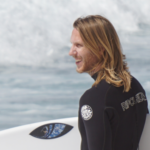My name is Jason. I am a software engineering leader, I like to surf and I love going on adventures in my camper van with my wife and dog.
How To Catch Waves
So you’ve mastered paddling into whitewash waves and popping up. The next step is to move out to the actual break and start catching open faced or green waves – essentially waves that haven’t broken yet. This is where it starts to get really fun, but also really challenging.
So the first thing we have to cover is where to actually sit when you are trying to catch open faced waves. Paddle out towards the waves, but keep an eye on where the waves are actually breaking. From there, you want to paddle out further and and sit maybe 10-15 feet beyond the break so that you can catch it as it’s breaking. If you sit where the waves are breaking, it’ll break on your back as you are paddling. Most likely you’ll be at a beach with other people, so look where they are sitting and go sit at that same distance. Find the guy who’s catching a lot of waves and study where he’s sitting relative to where the wave is breaking, that’s a good indication of where to be.
There is one fundamental difference between catching whitewash and actual waves. I believe knowing this difference is the key to really grasping how to catch waves. So if you are not having success, come back, and really think about this concept.
When you are catching small broken waves close to shore, you are letting the wave push you, you are using that forward power to get yourself moving.
Now with an unbroken wave, you are actually using gravity to get down the face of the wave.
As the wave approaches, you must match the speed of the wave with your paddling or it’s going to pass right under you.
The nose of your board must be lower than the tail of your board.
Now here’s another key thing to remember, once you feel that board start to pick up, really give it an extra paddle or two so you know you’re really in it, keep your chest/head low and close to the board, then pop up.
Paddling into waves should tire you out, these should be sprint paddles. And by sprint paddles I’m just talking about really paddling your butt off. When you’re paddling out to the break you can take slower strokes, but time them right so you are getting over whitewash correctly and so you aren’t taking breaking waves on the head, but paddling into a wave should be you going all out.
So again, we’re taking advantage of gravity, we need to match the speed of the wave with our paddles, and once we feel that wave pick us up, give it an extra one or two insurance paddles and then do your pop up.
Now figuring out what wave to catch is going to take some time, and you’ll get better as you spend more time in the water learning how to read the ocean.
If you’re attempting to paddle too early, the wave will not be completely formed yet, so there won’t be enough power there to get you moving.
If you’re too late, the wave will already be crashing or already broke and then you are just in the whitewash.
You want to find that in between where the wave is standing up and just starting to curl.
Here are a few things you can look to adjust as you start trying to catch open faced waves:
Be more forward on your board then you would be when paddling into whitewash – not so forward that your nose is dipping into the water, but you want to be a little more forward so you are planing correctly and paddling at maximum speed.
Make sure to keep that back arched and keep those arms back when you’re starting to pop up, don’t put them out forward to stop yourself. If you start to feel like you are going to nose dive, get those arms back, and arch your back and pop up or just get to your knees and you should be able to save yourself from nose diving.
You are going to nose dive (or “pearl”), it’s part of the learning process, and there are a couple reasons for it. Either you aren’t paddling fast enough, you stood up too slow, your nose dipped into the water, or your weight is too far forward. Now you may think if I’m nose diving I’m too far forward, well probably not. If you move back when you’re paddling, there’s a good chance you’ll just keep missing waves. Remember what we talked about earlier, you must get the nose of your board lower than the tail of your board.
Don’t wait too long to pop up, if you wait until you’re at the bottom of the wave you’ll miss it and lose all your speed. Feel that wave pick you up, give it an extra paddle or two, and explode into your pop up.
Look behind you as you are paddling so you can adjust speed as necessary. The only way to learn is to see what you are doing and what you are actually paddling into. You may think you are paddling at the right time, but if you aren’t checking on the wave and adjusting, there is a good chance you are misjudging how and where the wave is breaking.
Don’t angle your take-off when you are first starting out, just paddle straight towards the beach, focus on catching that wave and popping up. You can advance to angling your pop-up later on.
If you are really having a hard time, take a boogie board out or just surf on your stomach with your board. Sometimes all it takes is riding a few waves on your stomach to figure out what it feels like when you catch a wave correctly. Once you get that feeling ingrained, you’ll have more energy to focus on your pop-up and actually surfing.
I guarantee this is going to be the most challenging part of surfing for awhile, so don’t lose hope if it’s taking you quite a few sessions to catch waves in the line up. If you need help, tips, or feedback on problems you’re having, feel free to leave a comment on my YouTube video or shoot me an email. In the next article we’ll quickly go over surf etiquette so you stay safe and don’t immediately create enemies in the water.

